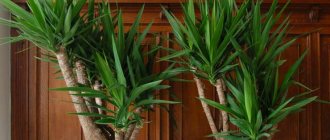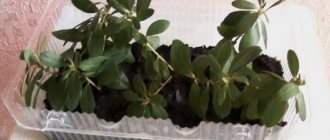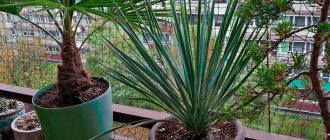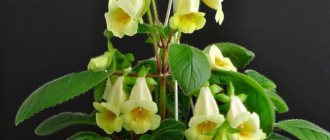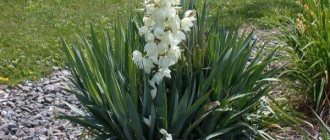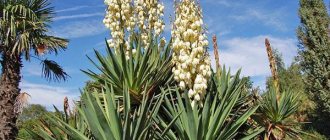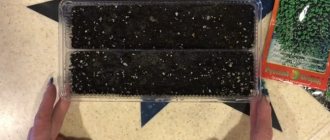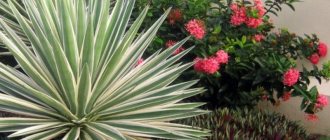Propagating yucca at home does not require much effort. You can get a new plant by dividing an adult bush or rooting cuttings and parts of the stem. Seed propagation at home is extremely rare. To grow strong and healthy seedlings, it is necessary to take into account the biological characteristics of the flower and follow the recommendations of experts.
Yucca is unpretentious and reproduces well at home
How to propagate and root yucca?
Young offspring are most often obtained from an adult healthy plant. Already in the first years of cultivation, with proper care, a false palm tree can produce several shoots. Cuttings are rooted in water or wet sand. You can use expanded clay or specially formulated soil.
Components for soil mixture:
- washed sand - 1 part;
- humus (preferably leafy) - 0.5 parts;
- turf soil - 1 part.
Ready-made soil for rooting cuttings can be purchased at the store.
A plant planted in the ground forms its first roots within two months.
Experts recommend propagating indoor palm trees using one of the following methods:
- trunk parts;
- air layering;
- cut off top;
- offspring;
- seeds.
Vegetative propagation begins in April-May. This is a period of active growth for yucca, so rooting goes especially well. Separation of offspring is also best done in spring and summer or during transplantation of an adult bush.
Yucca at home
It turns out that yucca, which we often mistake for a palm tree, has nothing in common with this tropical tree. This evergreen tree plant belongs to the Asparagus family and is distinguished by a variety of varieties. The culture came to us from Mexico and the central parts of America.
Yucca - or, as it is also called, false palm - is easy to propagate and grow. Feels good on southern and eastern windows; in winter it requires lower temperatures.
This is interesting. In southern Europe, yucca filamentous grows well in open ground conditions. It can easily withstand short-term drops in ambient temperature to -10…-15°C.
The woody stem ends in a tuft of lanceolate leaves. Some species initially have a branched trunk. At home, the plant produces white, bell-shaped buds. Does not bloom when grown indoors.
At home, Yucca aloifolia and Yucca elephantipes are usually cultivated. We'll talk about them below.
Reproduction by apex
From an adult plant, about 10-15 cm of the stem with the apical leaf rosette is cut off. The cut areas are treated with wood ash or crushed coal. The top stem is dried for 2-3 hours. Rooted in three ways:
- in wet sand, perlite, vermiculite;
- in a nutrient substrate (as for seeds);
- in warm boiled water with an activated carbon tablet.
Place a transparent bag over the container with the apical segment and place it in a shaded place with a temperature of about +20C. Water as needed to prevent the sand or substrate from drying out. The bag is removed for 30 minutes every day. At this time, the foliage is sprayed with a solution of fertilizers for succulents, and rotten leaves are removed.
After 1.5-2 months, roots will appear. The yucca is replanted, the pot with the plant is left in the shade for 2-3 days and then transferred to a sunny corner.
Propagation of potted Yucca plant
Why propagate yucca? As soon as a person picks up this amazing plant, he will want to purchase even more copies of this beauty for his home or give it as a gift. And the green corner created with the help of yucca will not leave anyone indifferent. This plant can be called a diamond in home decor. Yucca can be propagated in several ways, namely:
- at the top of the stem;
- cuttings;
- shoots;
- seeds;
- stem;
- offspring;
- offspring.
Each distribution method is simple and does not require much time or effort. And with home breeding, the gardener receives additional plants for his green collection.
Tops
If the florist plans to create several fan-shaped tops on the yucca stem. Then wait until the plant reaches 35 cm in height. Then the top of the yucca is cut off with a knife so that a few leaves remain on the main plant. Powdered charcoal is applied to the cut. Soon young shoots will appear at the cutting site.
At the same time, the cut tops can be used to produce a new plant. They are air dried for several hours and then dipped in wet sand or water. If water is selected, it should be heat treated and cooled to room temperature before use.
Pay attention to the lower leaves of the seedlings in the water or sand. If they begin to rot, it is recommended to remove the damaged parts and replace the water with fresh water. When the first roots appear, transplant the yucca into a separate pot.
Cuttings
The yucca stem has dormant buds that can produce new shoots. All the nutrients that the plant receives from the soil are directed to the development of the crown, and while it is on the trunk, the buds will not wake up and produce new shoots. Several new shoots are obtained by cutting the trunk into 20 cm pieces.
Finished specimens are immersed in a moist substrate with the addition of sand, buds inside, to form roots. Cover the container with a glass jar. The mini-greenhouse is located in a quiet corner where the temperature is maintained at +20ºC and the soil is watered daily. After two weeks, roots will appear and each seedling will be planted in a separate pot.
To obtain new shoots through cuttings, it is best to use the period from February to April.
Cuttings
Throughout the warm season, yucca is covered with root shoots. They should be removed so that the plant can grow better. Do not rush to throw away excess roots; use them to create new yucca bushes.
In autumn, the shoots are carefully cut off from the mother plant and planted in damp sand. After planting, water thoroughly and cover with a glass jar.
It takes about two months for new sprouts to form, so the jar should be opened and ventilated regularly throughout the process. This should be done several times a week. Make sure the temperature in the breeding room is at least +20ºC.
When new shoots appear on the roots, transplant them into a separate pot. Replant slowly and allow time for continuous rooting. After the first roots appear, at least 2 weeks must pass before planting in a permanent place.
This method is the only one that involves growing yucca in the fall.
By seed
Yucca produces a large number of seeds in its native soil. In our latitudes it almost never blooms. But if its seeds appear for sale in a flower shop, then you can try to get offspring this way. The main condition is that the seeds must be fresh. In other words, no older than one year.
To get seedlings using seeds, make containers in the form of a greenhouse. Mix turf soil with sand in a 1:1 ratio and moisten well. Place the seeds on the surface of the mixture without pressing them in. Cover the top with glass or foil to create a greenhouse. Remove the glass or foil every day for ventilation and moisten the soil several times a week. With this procedure, the first shoots appear after four weeks.
Stem
The yucca flower can be propagated by cutting the stem during the summer. This is one of the simplest propagation methods. The stem is cut into pieces 15 cm wide. Then all the cut parts are placed in moist soil so that the buds are near the ground and pressed. In a few weeks the first shoots will appear. They are carefully separated and planted in separate pots. Cover the cut area of the plant with garden varnish.
This is a simple method that does not require tedious maintenance. New shoots appear within a short time.
Stems
Propagation by cuttings is carried out in early spring. Strong shoots are cut off from the trunk of an adult bush. Particular attention should be paid to cuts on the mother plant; they should not be too deep, as this will damage the stem and lead to death. The cut itself must be sealed. An infusion of garden or activated carbon, crushed into powder, will be effective.
The scion should be placed in sandy soil, previously well moistened. If the recommendations are followed correctly, the seedling will grow stronger within a month.
Babies
With proper care of yucca, young plants can appear in the first year of its life. And separating root or stem shoots is beneficial for the mother plant. Make sure that there are no more than six shoots on one stem; an excessive number of shoots is harmful for the normal growth and development of the main bush.
Carefully cut the suckers from the parent tree with a knife. The cutting depth is controlled and should not be too deep so as not to damage the main trunk. After separating the offspring, plant them in a container with damp sand. Sprinkle generously with water and cover with a glass jar.
Place the seedlings in a sunny place and maintain a room temperature of +20ºC. Water the cuttings weekly and keep the sand moist.
Young yucca takes root within two months. After this period, the plant is transplanted into a pot for further growth. The substrate must be prepared and fertilized in advance. Soil intended for cacti or palm plants is ideal for yucca. It can be purchased in specialized stores.
Yucca palm and its propagation at home is not only pleasant, but also beneficial for the plant. For example, the Shoot Pruning Method reduces the thickness of the mother yucca crown and relieves it of excessive pressure. Ruthlessly remove excess shoots and sprinkle the cut areas with charcoal. This will help prevent rotting.
Propagation by cuttings
Part of the stem is sawed off and divided into several parts up to 20 cm long. The sections are disinfected. The cuttings are dried in the fresh air for 2-3 hours.
Work order:
- Pots or a deep container are filled with a mixture of sand and peat (1:1).
- The lower end of the cutting is buried 3-5 cm into the moist substrate. It is convenient to use pots here. The second option is to place the cuttings horizontally in a container. They are lightly pressed into the substrate, but not covered on top.
- The pots are covered with transparent bags or plastic balloons. The containers are covered with film.
- Greenhouses are placed in the shade, ventilated daily, and maintain moderate substrate humidity and a temperature of about +20C.
- With the appearance of buds, the shelter is removed, and the plant is fed with any nitrogen fertilizer.
- After 2 months, the yucca is transplanted. Horizontal petioles are first divided into parts according to the number of sprouts. Each part is placed in a separate pot.
Typical mistakes during transplantation
If the operation is done carefully and correctly, it should not cause significant harm to the yucca, even when the roots were stripped. Often the transplant is accompanied by the following errors:
- drainage that is too shallow can clog the lower holes;
- the container is filled to the brim with the substrate; during irrigation there is nowhere to pour water;
- deepen or protrude the root collar;
- they forgot to water the plant beforehand, when replanting is done, and not transshipment, the roots are torn off;
- after stripping the lower shoots, do not treat with fungicide;
- start feeding too early - if the roots have not healed, they will get a chemical burn;
- the transplant is carried out at the wrong time;
- after abundant irrigation they do not pause;
- place the pot in the shade or in bright sun;
- They forget to water after surgery.
Reproduction by shoots
Root and stem shoots are suitable for propagation. It is more convenient to root sprouts in water. An activated carbon tablet will prevent rotting. Fresh aloe juice stimulates root growth (5-7 drops per 200 ml). Add water as needed or change it when it becomes cloudy.
Shoots can be rooted in wet sand, perlite and nutrient substrate. They are buried 1-3 cm and create a greenhouse effect. Standard care: daily ventilation, maintaining optimal humidity and temperature. When roots appear, the plants are replanted.
Harmful insects
As a rule, they attack yucca very rarely, but such cases still happen. Among the most common and dangerous pests are the following:
- Spider mites. It is very difficult to remove them because they grow under the leaves. You can find out about unwanted inhabitants by looking at the leaves. They begin to turn yellow and become covered with white spots. If you do not take any action, the greenery gradually dries out and falls off. The main reason is too dry indoor air. To combat spider mites and prevent their occurrence, plants are sprayed with special chemicals (for example, Fufan, Actellik or Derris). In addition, it is very important to increase air humidity.
- Pads. They settle on stems and leaves and feed on plant sap. As a result of the attack, the yucca begins to grow poorly and dry out. If the pests are not defeated, the tree dies. Actellik is considered the most effective remedy against these insects.
Here, in fact, are all the insects from which the plant in question most often suffers. Having noticed signs of their appearance, it is necessary to take measures to combat them as soon as possible. Prolonged inactivity can lead to the death of the plant.
Propagation by seeds
Yucca blooming indoors is a rare occurrence. In nature, the plant is pollinated by a symbiont insect (yucca moth). At home, seed pods do not form. Flower growers buy ready-made seeds (3-5 pieces per package). The seeds have a dense, glossy black shell. The average seed size is about 5 mm. Without pre-treatment they germinate in a month.
Work order:
- Suitable containers are small pots, a tall plastic container with drainage holes.
- The nutrient substrate is a mixture of turf (2) and coniferous (2) soil with coarse sand (2) and humus (1). Ready-made soil for succulents or palm trees is suitable.
- Scarification of seeds will reduce the germination period to 2 weeks - their shells are slightly ground off with sandpaper and kept in a growth stimulator for a day.
- A centimeter layer of drainage is poured into the container and filled with soil. The seeds are buried 5 mm into moist soil.
- The container is closed with a lid or covered with film. The greenhouse maintains moderate soil moisture, the temperature is not lower than +25C and is ventilated daily.
- When the first leaf develops, the seedlings are planted in separate pots with a volume of up to 100 ml. After the formation of 5 full leaves, the yucca is transplanted into a container 2 cm wider than the volume of the root system.
Choosing a pot
For the operation to be successful and for the yucca to grow healthy, the correct selection of the container is important. If it is too large or small, the flower develops slowly and often gets sick. It should be taken into account that the material of the flowerpot can grow together with the roots, not allow air to pass through at all, or be very light.
Pot size
A regular shaped pot is suitable for yucca. For the new one, the diameter of the upper hole is increased each time:
- by 2-3 cm for single plants placed on the windowsill;
- for large sizes or groups - 5 cm at a time.
If replanting is carried out with root stripping or shoots are planted, the container may need not more, but less than the previous one. Determine the required size as follows:
- the root (clump of earth) should fit comfortably in the pot, leaving space at the bottom for a drainage layer;
- A finger fits freely between the flower and the walls of the container.
Material
For yucca, it is better to choose a plastic pot - there are always several drainage holes. If necessary, it is easy to expand them or make new ones with a hot nail or soldering iron. It is easy to remove the earthen lump from such a container - you just need to slightly dent the flexible walls.
The disadvantage of the material is that the pot is light; the large yucca with its top supporting the ceiling often turns over.
Despite good conductivity for moisture, air and heat, great stability, it is better not to use a ceramic pot for yucca. It contains only one hole, but it is impossible to make new ones; the water often stagnates and the roots rot. It is difficult to get out an overgrown yucca - you will have to break the flowerpot or separate the lump and walls with a knife.
Transplanting most indoor plants into containers without holes, coated inside or outside with glaze, is not recommended. But they look attractive, the design can be matched to the interior, used as a flowerpot - put the “right” pot inside.
A good choice is new branded flowerpots with special devices, such as Lechuza. True, their cost is very high.
The role of drainage and bottom holes
Some gardeners transplant into impenetrable pots and never use expanded clay or its substitutes. And they are even proud that they know how to water plants so that excess moisture does not accumulate at the bottom of the container. But with each irrigation, the flowers are not pulled out of the pot to check if there is water there. And the root can rot gradually.
In addition, the purpose of drainage holes is not only to remove liquid remaining after watering. And expanded clay has other functions than preventing the roots from coming into contact with the bottom of the container.
Houseplants often suffer from poor aeration when cared for at home. Bottom holes and drainage improve air flow to the roots, which is very important for all plants. Especially for those like the yucca flower - inhabitants of rocky wastelands and mountain ranges, where stagnation of moisture is in principle impossible, and the soil structure promotes excellent air exchange.
How to weight a container
To prevent the pot from turning over, a stone or other chemically neutral object with a large weight is placed at the bottom. If the transplant is made into a small, light flowerpot, it is placed in a beautiful heavy pot, the gap is filled with wet sphagnum - at the same time the humidity will increase, the flower will become stable.
Reproduction by air layering
This method will help preserve the healthy part of the dying yucca. Work order:
- The trunk is stripped of bark around its circumference, with a strip of 1-1.5 cm. If the plant is sick, the bark is removed 10 cm above the affected area.
- The area where the bark is cut is wrapped in a layer of damp sphagnum moss, covered with film and fixed.
- In addition to regular care, make sure that the moss does not dry out.
- After a month, check the degree of root development. They should be strong, from 2 to 5 cm long.
- The cuttings are separated from the mother bush and rooted in the ground.
Main problems
Above we described in detail how to care for yucca. But even if you follow all the rules and recommendations, not everything goes as it should. Gardeners often face various problems. Now let's look at them in more detail. Among the most common are the following:
- The leaves are curling up. Most often, this happens due to too sudden a change in temperature, for example, when someone in the house forgot to close a window or left a door open. To solve this problem, you need to make sure there are no drafts and feed the plant.
- The leaves began to dry. The main reason is low air humidity in the apartment or non-compliance with the watering regime.
- The trunk becomes longer and the color of the leaves fades. Make sure the tree gets enough sunlight. It is best to place the pot on the windowsill. If the problem occurs in winter, install an artificial light source.
- The leaves began to fall. This is one of the most common problems that many new gardeners face. In most cases, it is associated with improper watering, so the first thing you need to do is review it. If the rhizome has not been affected by rot, then over time the yucca will return to its original appearance.
- The trunk has become soft and the leaves are withering. If the greens have not turned yellow and are not falling off, then removing the affected tissue can help get rid of the problem. If the main shoot has become completely soft and the leaves have turned black, then it will no longer be possible to save the tree. It is thrown out along with the ground.
If the plant begins to gradually fade, this may be a sign of damage to some disease or harmful insects. In this case, the palm tree is dug up, rotten roots are cut off and treated with a fungicide. It would also be a good idea to transplant the yucca into another pot filled with new substrate. At the same time, it is not watered for the first 2-3 days.
Reproduction by offspring
With proper care, yucca can have children in the first year of life. Separating root or stem shoots from a false palm tree is even useful - for normal growth and development, you need to ensure that there are no more than five shoots on the plant at the same time.
The process of rooting children is as follows:
- It is advisable to sprinkle the cuts on the parent tree and on the offspring itself with crushed charcoal;
- separated offspring must be planted in containers with damp, clean sand, watered and covered with a glass jar or plastic bag;
- It doesn’t hurt to provide young plants with good humidity and a temperature of at least 20 °C;
- it is very important to ventilate the “greenhouse” daily and water the plant as needed;
- root formation will occur in a period of approximately two months;
When the yucca has taken root, you need to transplant it into a permanent pot with good soil and pieces of charcoal in it.
Which method is the most effective?
In apartment conditions, yucca is rarely propagated by seeds.
This method is quite labor-intensive and time-consuming. It takes at least 2 years for a seed to grow into a flower of sufficient size. Vegetative propagation in an apartment is more preferable. It allows you to get a decorative yucca in just a few months.
When the top is rooted or the rhizome is divided, a large young plant grows very quickly . And when propagated by stem fragments, several small young specimens can be obtained from one segment.
Optimal timing for reproduction
Seed propagation is carried out immediately after collecting the seeds, since they quickly lose their ability to germinate. Vegetative propagation is carried out from April to June. In the spring, during the period of active growth, cuttings and apical shoots take root well. Separation of offspring is carried out both in spring and summer if it is necessary to replant the plant.
Basic requirements for capacity:
- the presence of holes for water drainage;
- volume corresponding to the size of the root system.
When is the best time to replant garden yucca?
The plant cannot be allowed to grow in the same place for a long time. Otherwise, it will grow greatly. The bushes need to be replanted periodically. It is better to do this in May or August.
In doing so, follow these recommendations:
- When you dig up the plant, do not damage the root system.
- Deepen the roots to a depth of 70 cm.
- Replant the cuttings as a separate plant.
- Apply fertilizer.
After transplantation, the plant will bloom within 10-12 months.
How to feed garden yucca?
- Cow or bird droppings should not be used to fertilize yucca Such components provoke dryness of the plant. Monitor the amount of fertilizer. If there are too many of them, leaves will grow, but flowers will not form.
- The first fertilizing is applied when the first leaves appear. Use preparations that are used to fertilize indoor plants.
- You can add complex mineral components , which contain some nitrogen. Prepare the solution according to the instructions so as not to harm the plant. Pour 1 liter of fertilizer under each bush.
Feed your yucca to make it bloom beautifully
How to prune garden yucca?
- The main purpose of pruning garden yucca is to rejuvenate the plant. To awaken the side buds, cut off the main stem. If new shoots are not needed, it is enough to remove the damaged leaves.
- Start pruning in the fall, when the crop has finished flowering. First remove damaged leaves and stems. In order not to disturb the structure of the plant, the leaves do not need to be cut off completely. It is enough to step back 2 cm from the trunk.
Care after breeding
Further care consists of standard procedures for indoor plants. Care rules:
- Watering - young plants are watered in small portions, not allowing the top layer of soil to dry out. Adult specimens are watered once a week in the warm season, and once every 2-3 weeks in the autumn-winter season. Experienced gardeners recommend calculating the amount of moisture based on the volume of soil - 1 liter of water per 4 liters of soil. Excess moisture is drained from the pan to prevent rotting of the roots. In the summer, to wash away dust from the foliage, bathe the plant once a month under a warm shower.
- Feeding is carried out in the spring and summer. For fertilizer, special liquid formulations for palm trees are used, for example, “Stimovit”. The drug is diluted with water in a proportion twice as large as indicated in the instructions. Apply once every 2-3 weeks, spraying the green part.
- Pruning - formative pruning is carried out after the yucca leaves the dormant period. You can trim an adult plant whose trunk diameter is at least 2 cm. Pruning is carried out with pruning shears at a distance of 40 cm from the soil surface. The cut is treated with crushed coal and filled with wax to prevent rotting. The procedure stimulates the formation of lateral shoots and creates growth in several trunks.
- Transplantation - young plants are replanted annually, adults - once every 3-4 years. The procedure is carried out in the spring using the transshipment method.
For a month, the yucca is not disturbed by care procedures (except for watering): it must take root and adapt.
Soil for yucca
The substrate needed is light, loose, well permeable to water and air, with a neutral reaction, and a stable structure. Specialized soil for yucca is no longer uncommon in flower shops. You can replant the crop in Palma soil or add sand, perlite, brick chips, small pebbles (minimum 20% of the volume) to the universal substrate for decorative foliage indoor plants.
You can prepare your own soil for yucca using the following in equal parts:
- deciduous and turf land;
- sand;
- neutral peat;
- completely rotted humus.
